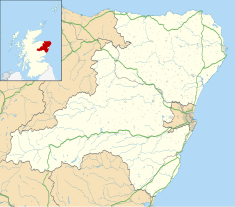
Turriff is a town and civil parish in Aberdeenshire in Scotland. It lies on the River Deveron, about 166 feet (51 m) above sea level, and has a population of 5,708. In everyday speech it is often referred to by its Scots name Turra, which is derived from the Scottish Gaelic pronunciation.

Peterhead is a town in Aberdeenshire, Scotland. It is Aberdeenshire's biggest settlement, with a population of 18,537 at the 2011 Census. It is the biggest fishing port in the United Kingdom for total landings by UK vessels, according to a 2019 survey.
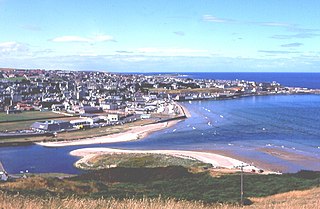
Banff is a town in the Banff and Buchan area of Aberdeenshire, Scotland. It is situated on Banff Bay and faces the town of Macduff across the estuary of the River Deveron. It is a former royal burgh, and is the county town of the historic county of Banffshire.

Macduff is a town in the Banff and Buchan area of Aberdeenshire, Scotland. It is situated on Banff Bay and faces the town of Banff across the estuary of the River Deveron. Macduff is a former burgh and was the last place in the United Kingdom where deep-water wooden fishing boats were built.

Longside is a village located in Aberdeenshire, Scotland, consisting of a single main street. It lies seven miles inland from Peterhead and two miles from Mintlaw on the A950. Its population in 2001 was 721. The River Ugie flows through it.
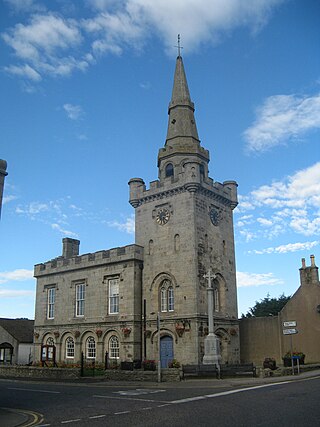
Strichen is a village in Aberdeenshire, Scotland. It sits on the A981, connecting it to New Deer 7.2 miles (12 km) to the southwest and Fraserburgh 8 miles (13 km) to the north-northeast, and the B9093, connecting it to New Pitsligo about 4 miles (6.4 km) due west. The village got its name from Lord Strachen. It is situated on the River Ugie at the foothills of Mormond Hill. The Strichen White Horse is constructed of quartz on Mormond Hill, some 1,500 m (1,600 yd) northeast of Strichen.
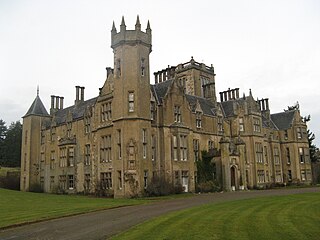
John Smith was a Scottish architect. His career started in 1805 and he was appointed as the official city architect of Aberdeen in 1807, the first person to hold this post. Together with Archibald Simpson, he contributed significantly to the architecture of Aberdeen, and many of the granite buildings that gave the city the nickname "The Granite City" or also "The Silver City" are attributed to them.

The Pitfour Estate, in the Buchan area of North-East Scotland, was an ancient barony encompassing most of the extensive Longside Parish, stretching from St Fergus to New Pitsligo. It was purchased in 1700 by James Ferguson of Badifurrow, who became the first Laird of Pitfour.

Kinnairdy Castle is a tower house, having five storeys and a garret, two miles south of Aberchirder, Aberdeenshire, Scotland. The alternative name is Old Kinnairdy.

Tyrie is a hamlet and parish in the Banff and Buchan district of Aberdeenshire, north-east Scotland. Tyrie is located on the A98 road, around 5.5 miles (8.9 km) south-west of Fraserburgh. Tyrie parish includes the larger settlement of New Pitsligo, 5 miles (8.0 km) to the south. There is a primary school in the village. Tyrie's St Andrew's Parish Church was built in 1800 and is a category B listed building. The church contains a Pictish symbol stone, known as the Raven Stone, which was discovered on the site of the old parish church. The ecclesiastical parish was united with Strichen parish in 2002.

Robert Gordon Wilson (1844–1931) was a 19th/20th century Scottish architect based in Aberdeen. He was from a strong United Presbyterian background and specialised in churches for the United Presbyterian Church and Free Church of Scotland.

Peterhead Town House is a municipal structure in Broad Street, Peterhead, Aberdeenshire, Scotland. The building, which was the headquarters of Peterhead Burgh Council, is a Category B listed building.

Macduff Town Hall is a municipal building in Shore Street, Macduff, Aberdeenshire, Scotland. The structure, which was the meeting place of Macduff Burgh Council, is a Category B listed building.

Fraserburgh Town House is a municipal building in Saltoun Square, Fraserburgh, Scotland. The building, which was the headquarters of Fraserburgh Burgh Council, is a Category B listed building.
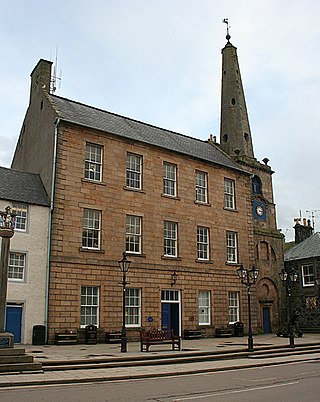
Banff Town House is a municipal building in Low Street, Banff, Aberdeenshire, Scotland. The building, which is used as a customer service point and job centre, forms part of a complex consisting of a steeple, completed in 1767, which is a Category A listed building, and a town house, completed in 1797, which is also a Category A listed building.

Pittenweem Parish Church and Tolbooth Steeple is an ecclesiastical and municipal complex in the High Street, Pittenweem, Fife, Scotland. The structure, which is used as the local parish church, is a Category A listed building.
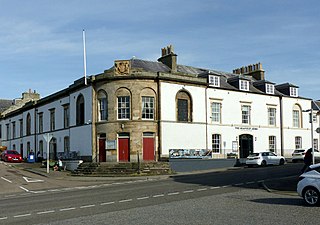
Cullen Town Hall is a municipal building in The Square, Cullen, Moray, Scotland. The structure, which is currently used as a heritage centre, is a Category B listed building.

Milnathort Town Hall is a municipal building in New Road, Milnathort, Perth and Kinross, Scotland. The structure, which is currently used as community events venue, is a Category B listed building.

Banff Sheriff Court is a judicial structure in Low Street, Banff, Aberdeenshire, Scotland. The structure, which was the headquarters of Banffshire County Council and was also used as a courthouse, is a Category B listed building.

